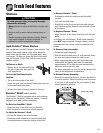
19
Food Storage Tips
Fresh Food Storage
• The fresh food compartment of a refrigerator should
be kept between 34°-40° F (1°-4° C) with an
optimum temperature of 37° F (3° C). To check the
temperature, place an appliance thermometer in a
glass of water and place in the center of the fresh
food compartment. Check after 24 hours. If the
temperature is above 40° F (4° C) adjust the controls
as explained on page 10.
• Avoid overcrowding the fresh food shelves. This
reduces the circulation of air around the food and
results in uneven cooling.
Fruits and Vegetables
• Storage in the crisper drawers traps humidity to help
preserve the fruit and vegetable quality for longer
time periods (see page 17).
• Sort fruits and vegetables before storage and use
bruised or soft items first. Discard those showing
signs of decay.
• Always wrap odorous foods such as onions and
cabbage so the odor does not transfer to other foods.
• While vegetables need a certain amount of humidity
to remain fresh, too much humidity can shor
ten
storage times (especially leafy vegetables). Drain
veget
ables well
before storing.
• Wait to wash fresh produce until right
before use.
Meat and Cheese
• Storage in Wide-N-Fresh
TM
drawer helps preserve
quality for longer time periods.
• Raw meat and poultry should be wrapped securely
so leakage and cont
amination of other foods or
surfaces does not occur.
•
Occ
asionally mold will develop on the sur
face of
hard cheeses (Swiss, Cheddar, Parmesan). Cut off at
least an inch around and below the moldy area. Keep
your knife or instrument out of the mold itself.
Do not try to save individual cheese slices, soft
chee
se, cott
age chee
se, cream, sour cream or yogur
t
when mold appears.
Dairy Food
• For milk and cream, store in the Temperature
Controlled Beverage Chiller which is designed to
maintain a lower temperature for optimum freshness
and life.
• Most dairy foods such as milk, yogurt, sour cream
and cottage cheese have freshness dates on their
cartons for appropriate length of storage. Store these
foods in the original carton and refrigerate
immediately after purchasing and after each use.
Frozen Food Storage
• The freezer compartment of a refrigerator should be
kept at approximately 0° F (-18° C). To check the
temperature, place an appliance thermometer
between the frozen packages and check after 24
hours. If the temperature is above 0
° F (-18° C),
adjust the control as de
scribed on page 10.
• A freezer operates more efficiently when it is at least
two-thirds full.
Packaging Foods for Freezing
• To minimize dehydration and quality deterioration use
aluminum foil, freezer wrap, freezer bags or air
tight
containers. Force as much air out of the packages as
possible and be sure they are tightly sealed. Trapped
air c
an cause the food to dry out, change color and
develop an off-flavor (freezer burn).
•
Overwrap fre
sh meat
s and poultry with suit
able
freezer wrap prior to freezing.
•
Do not refreeze meat that has completely thawed.
Loading the Freezer
• Avoid adding too much warm food to the freezer at
one time. T
his overloads the freezer
, slows the rate of
freezing and can raise the temperature of frozen
foods.
• Leave space between the packages so cold air can
circulate freely
, allowing food to freeze as quickly as
possible.
Refer to the
Food Storage Chart on page
s
20
and
21
for
approximate storage times.


















